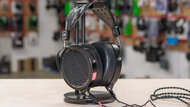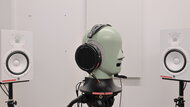Open-back headphones deliver an immersive listening experience through their unique design. They can produce a wide and spacious soundstage that interacts with your surroundings and makes your listening experience more immersive. Unfortunately, they leak a lot of sound, even if you're listening to music at a reasonable level, and can distract people around you. They also struggle to reduce background noise in your environment because they aren't designed to isolate you. If you're looking for something for mixed-use, check out our recommendations for closed-back headphones. However, this is the place to be if you're seeking a great-sounding experience from your headphones.
We've tested over 850 pairs of headphones, and below are our recommendations for the six best headphones with an open-back design that you can buy. If you're still looking for more headphones, look at our recommendations for the best audiophile headphones and the best headphones for music.
Quick Look





-
Best Open-Back Headphones
 Audio Reproduction Accuracy8.5Frequency Response Consistency8.4Peaks/Dips8.0See all our test resultsStereo Mismatch8.4
Audio Reproduction Accuracy8.5Frequency Response Consistency8.4Peaks/Dips8.0See all our test resultsStereo Mismatch8.4The best open-back headphones we've tested are the Sennheiser HD 800 S. These premium dynamic driver headphones are the best for sound, but are definitely an investment. Aside from the cost of the headphones, you'll need a powerful amp or audio interface to use them, which is an extra expense if you don't already have one. However, if you want the best, these create an outstanding sense of depth and width to your audio, and really lend your audio some of the qualities of angled reference monitors. They also have an excellent build quality and a very comfortable fit for most people, so you can listen for hours without experiencing much fatigue.
Although they lack a thumpy low bass due to their open-back design, they have a bit of extra high bass to add warmth to the mix. Instruments and vocals sound clear and natural. Their balanced sound profile is suitable for all types of audio content. However, if you prefer a warmer, bassier sound, check out our Best Warm Sound Profile pick, the Audeze LCD-X, which we discuss further down the page. That said, if you've the cash to spend and are after speaker-like immersion and a comfortable, barely-there fit, it's hard to look past the Sennheiser.
-
Best Upper Mid-Range Open-Back Headphones
 Audio Reproduction Accuracy7.9Frequency Response Consistency7.6Peaks/Dips7.6See all our test resultsStereo Mismatch7.1
Audio Reproduction Accuracy7.9Frequency Response Consistency7.6Peaks/Dips7.6See all our test resultsStereo Mismatch7.1The best mid-range open-back headphones we've tested are the HiFiMan Arya Stealth Magnet Version. These are a pair of planar magnetic headphones with a comfortable, sturdy design. They're quite a bit cheaper than the Sennheiser HD 800 S, but you have to make a few tradeoffs in exchange for those savings. First, the HiFiMan can't produce as immersive or speaker-like a sound as the Sennheiser. They're also heavier and less secure on the head, which can make them less comfortable for long listening or mixing sessions. Finally, their construction also feels a bit less sturdy, though that's reasonable given they cost less than half as much.
On the plus side, they also offer a thumpier, punchier low-end than the Sennheiser, making these cans a good choice for bass-heads. The rest of the frequency range is also well-balanced, so voices and instruments alike sound true-to-life. Their treble range is detailed and clear, making it easy to hear details like pick attacks on acoustic guitars. Their slightly bright sound signature also makes these great for analytical listening or more technical tasks like mixing or mastering audio. If you prefer a slightly warmer sound, check out our next pick, the Sennheiser HD 490 PRO.
-
Best Mid-Range Open-Back Headphones
 Audio Reproduction Accuracy8.3Frequency Response Consistency8.3Peaks/Dips8.2See all our test resultsStereo Mismatch8.0
Audio Reproduction Accuracy8.3Frequency Response Consistency8.3Peaks/Dips8.2See all our test resultsStereo Mismatch8.0If you want to save some cash, the Sennheiser HD 490 PRO are worth checking out for a dynamic driver design that won't destroy your bank account. They don't feel quite as sturdy as the HiFiMan Arya Stealth Magnet Version, but the HD 490 PRO are still an excellent choice for listeners who enjoy a balanced sound. They put out a similar amount of bass to the HiFiMan (which is still noticeably more than the Sennheiser HD 800 S) but have a slightly smoother sound, which some listeners may prefer. Vocals still have plenty of clarity and detail, but sounds like cymbals are quieter in the mix than they are with the HiFiMan. Whether you prefer that is a matter of taste. But it's worth noting that the HD 490 PRO don't produce as speaker-like a sound as either of our top two picks.
Still, the HD 490 PRO are pretty easy to drive, so you likely won't need a headphone amp with most devices. And they also offer consistent audio delivery, so you don't need to worry too much about their sound changing depending on the headphones' fit and positioning on your head. They also have a second set of earpads that change the sound signature a bit, meaning you have access to some extra physical customizability. Plus, if you wear glasses, the earpads have contours meant to fit around them without negatively affecting the bass response.
-
Best Lower Mid-Range Open-Back Headphones
 Audio Reproduction Accuracy8.0Frequency Response Consistency8.3Peaks/Dips7.5See all our test resultsStereo Mismatch8.6
Audio Reproduction Accuracy8.0Frequency Response Consistency8.3Peaks/Dips7.5See all our test resultsStereo Mismatch8.6Audiophile headphones tend to take a hit in performance once you get into the lower mid-range price point, but the Sennheiser HD 560S avoid that pitfall. These have a decent, albeit more plasticky, build quality than our more expensive picks on this list. But that design also keeps them lightweight and comfortable to wear for long periods of time. They're pretty stable on the head, too, so if you're an active listener who likes to headbang to your favorite Haken tunes, these are a good pickup.
Like most open-back headphones, their sound lacks a little low-bass thump, especially compared to the impressive bass put out by the Sennheiser HD 490 PRO, but their balanced sound is great for everything from podcasts to pop music. Instruments sound true-to-life, and vocals have enough clarity to cut through dense mixes. If you do prefer more bass at this price point and are set on open-backs, it might be worth taking some time to experiment with EQing your headphones. You might be surprised how much punch you can gain with a simple low-frequency boost, and the side effects are minimal.
-
Best Budget Open-Back Headphones
 Audio Reproduction Accuracy7.6Frequency Response Consistency7.7Peaks/Dips7.7See all our test resultsStereo Mismatch7.6
Audio Reproduction Accuracy7.6Frequency Response Consistency7.7Peaks/Dips7.7See all our test resultsStereo Mismatch7.6If you want to dip your toes into the world of open-backs without investing too much, try the Philips SHP9500. These entry-level over-ears are decently built for the price, but not as stable or durable as the more expensive Sennheiser HD 560S, and the fabric on their ear pads can tear over time. The swivelling ear cups also feel a little loose, so they're better suited for relaxed listening than swaying your head to the beat.
On the plus side, their flat, detailed sound is tuned for accuracy, so voices and instruments sound realistic. That makes these cans a great choice for acoustic and vocal-driven music. But unlike pricier options such as the Sennheiser HD 490 PRO, the Philips' lack of low-end punch means fans of genres like techno or deep house might feel the groove is a little lacking from their favorite tunes. If you want more thump at a similar price point, the Superlux HD 681 are worth considering. They offer a fuller bass range, but their semi-open design isn't as comfortable or breathable as our pick. The Philips also feel significantly better built, and have a smoother, less piercing treble range.
-
Best Warm Sound Profile Open-Back Headphones
 Audio Reproduction Accuracy7.4Frequency Response Consistency7.9Peaks/Dips7.9See all our test resultsStereo Mismatch8.7
Audio Reproduction Accuracy7.4Frequency Response Consistency7.9Peaks/Dips7.9See all our test resultsStereo Mismatch8.7The Audeze LCD-X are an audiophile favorite for their thumpy yet controlled low-end and smooth sound. They deliver more punch in the bass than other premium open-backs like the Sennheiser HD 800 S, but don't sacrifice much mid-range accuracy to do so. Instruments sound accurate, with plenty of detail and presence. The Sennheiser's brighter treble means they sound a bit more detailed than the Audeze, but many listeners prefer the latter's more laid-back presentation, especially over long listening sessions when ear-fatigue can creep in.
The Audeze are noticeably heavier than the Sennheiser, though both pairs offer a premium build quality, which you'd expect given their price. Despite the extra weight, the Audeze remain comfortable enough for long mixing or listening sessions. If there's one downside to the LCD's more relaxed tuning, it's that the high-mids and low-treble are a touch subdued. That means voices can sound a bit recessed, especially in dense mixes. If you prefer a slightly flatter, more detailed response in that region, the Audeze MM-500 are a great alternative to the LCD-X. But the MM-500 are more expensive than the LCD-X, and offer a touch less thump in the bass. It's also worth noting that neither Audeze model can quite match the wide, speaker-like soundstage of the Sennheiser HD 800 S, which remain the benchmark for spacious, immersive listening.
-
Best Open-Back Headphones For Gaming
 Audio Reproduction Accuracy7.6Frequency Response Consistency7.6Peaks/Dips8.6See all our test resultsStereo Mismatch5.8
Audio Reproduction Accuracy7.6Frequency Response Consistency7.6Peaks/Dips8.6See all our test resultsStereo Mismatch5.8While you can use any of the previous picks for gaming, none come with a microphone, so if you don't have a standalone mic and want headphones with one built in, it's worth considering the Drop + Sennheiser/EPOS PC38X instead. Their great boom mic makes your voice clear and natural over team chat. They can also create a greater sense of width and depth than most closed-back gaming headsets, which can be helpful when it comes to locating where enemy footsteps are coming from.
They're very comfortable and come with a choice of microfiber or velour ear cup padding, which is nice if you have a preference. Their flat sound profile suits dialogue and game soundtracks alike, with an accurate mid-range for easily parsing out dialogue. However, they lack low bass like most open-backs, and the treble is a bit dull. Like all the other headphones on this list, they're wired-only and lack companion software with sound customization features like an EQ. If you like to fine-tune your audio using an app and value gamer-centric features like more extensive on-ear controls, consider the Turtle Beach Atlas Air. These open-backs can be used wirelessly as well as wired, which adds to their flexibility. They also have a better mic than the Drop + Sennheiser. On the other hand, the Turtle Beach aren't quite as comfortable as our pick.
Notable Mentions
-
Audio-Technica ATH-ADX3000:
If you're looking for premium open-back headphones but can't stretch the budget to the Sennheiser HD 800 S, then the Audio-Technica ATH-ADX3000 are well worth considering. Like the Sennheiser, the Audio-Technica have a flat mid-range that reproduces all kinds of audio content well, but they can't match their more expensive rivals for perceived sense of depth and width.
See our review -
Beyerdynamic DT 1990 PRO MKII:
The Beyerdynamic DT 1990 PRO MKII are premium open-backs that are a bit more robustly built than the Sennheiser HD 490 PRO. Both headphones include extra ear pads and cables, but the Beyerdynamic include a case. Still, their frequency response isn't as smooth as the Sennheiser's, with a brighter sound that some might find a touch piercing. But if you like the Beyerdynamic sound, it's a refined take.
See our review -
HiFiMan Edition XS:
The HiFiMan Edition XS are a solid alternative to the Sennheiser HD 560. The HiFiMan offer a thumpier low-end, making them a great choice for modern genres like techno and hip-hop. But the tradeoff is a less well-controlled treble, so sounds like cymbals can be rendered a touch piercing at times, and they're not as comfortable for long listening sessions as the Sennheiser.
See our review -
Beyerdynamic DT 990 PRO:
The Beyerdynamic DT 990 PRO are lower mid-range headphones with a better build quality than the Sennheiser HD 560S and a more full-bodied sound thanks to their added high-bass, which some users may prefer for adding a sense of thickness to basslines. However, their audio cable isn't detachable, so if it gets damaged, you'll have to replace the entire unit.
See our review -
Sennheiser HD 6XX:
The Sennheiser HD 6XX are wired headphones with a more controlled treble than the Sennheiser HD 560S. That said, both pairs have fairly similar sound profiles, with the HD 560S offering a little more bass. The choice may come down to taste or availability, since the HD 6XX are only available direct from Drop, while the HD 560S are more widely available.
See our review -
Corsair VIRTUOSO PRO:
The Corsair VIRTUOSO PRO is a gaming headset with a boom mic that compares favorably to the Drop + Sennheiser/EPOS PC38X. They also have more warmth in the high bass, which can make soundtracks and footsteps in games feel more immersive. But some gamers might find the Corsair a bit too boomy and muddy. The Sennheiser is lighter on the head, so we think it's easier to wear for longer gaming marathons.
See our review
Recent Updates
Nov 18, 2025:
Our new upper mid-range pick is the HiFiMan Arya Stealth Magnet Version for their bright, accurate sound. The Sennheiser HD 490 PRO are now our mid-range pick. The Philips SHP9500 replace the Superlux HD 681 as our budget pick since they have a fully open-back design, and we also added the Audeze LCD-X as a new 'Best Warm Sound Profile' pick. Finally, we added the Sennheiser HD 6XX to our Notable Mentions in place of the Philips Fidelio X2HR.
Jul 22, 2025:
We added the Audio-Technica ATH-ADX3000 to our Notable Mentions as a cheaper alternative to the Sennheiser HD 800 S. We also updated this text throughout to align with Test Bench 2.0. Finally, we added a new summary feature to help our readers more easily identify the right headphones for their needs.
Mar 21, 2025:
We've updated this article to include the HiFiMan Arya Stealth Magnet as an alternative to the Sennheiser HD 800 S and edited the text for clarity. We've added the Beyerdynamic DT 1990 PRO MKII and Corsair VIRTUOSO PRO to the Notable Mentions list.
Dec 18, 2024:
We've made some changes to our picks. The Sennheiser HD 490 PRO replace the HiFiMan Edition XS, as they're more stable and control their sound profile better. The Sennheiser HD 560S replace the Philips Fidelio X2HR for the same reasons. Both previous picks were migrated to the Notable Mentions section.
Sep 18, 2024: The Turtle Beach Atlas Air Wireless are now mentioned in the 'Best Open-Back Headphones For Gaming' category because you can use them wirelessly, and they come with a companion app that lets you tailor the sound to your preferences.
All Reviews
Our recommendations above are what we think are currently the best headphones with an open-back design for most people to buy. We factor in the price (cheaper headphones win over pricier ones if the difference isn't worth it), feedback from our visitors, and availability (no headphones that are difficult to find or almost out of stock everywhere).
If you would like to choose for yourself, here is the list of all our reviews for open-back headphones. Be careful not to get caught up in the details. There are no perfect headphones. Personal taste and preference will matter more in your selection.






























